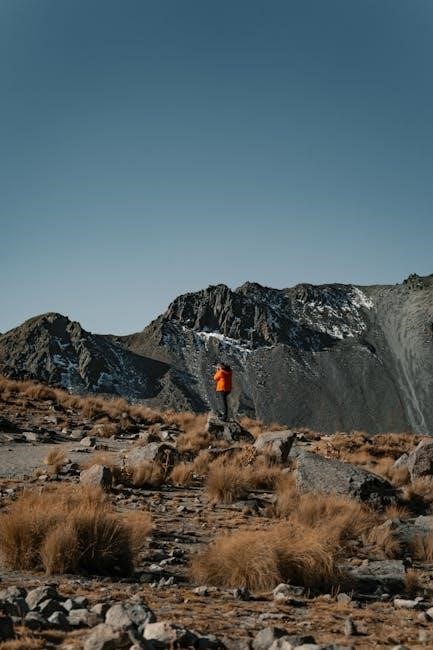The American Mountain Guides Association (AMGA) offers the Rock Guide certification, a prestigious credential for aspiring guides. It ensures high standards of safety, technical skill, and teaching ability.

Certification Process
The AMGA certification process includes completing the Rock Guide Course (RGC) and passing a rigorous exam, requiring significant time and financial investment.
2.1. Rock Guide Course (RGC)
The Rock Guide Course (RGC) is the entry-level program for AMGA certification, designed for climbers with strong technical skills. The course focuses on teaching and guiding techniques, emphasizing safety, risk management, and client care. Participants learn how to instruct various climbing disciplines, including single-pitch and multi-pitch environments. The RGC also covers essential skills like anchor placement, rope management, and group dynamics. It serves as a foundation for further certification, preparing candidates for the rigorous Rock Guide Exam. The course is both physically and mentally challenging, ensuring that guides meet the highest industry standards. Completion of the RGC is a critical step toward becoming a certified AMGA Rock Guide.
2.2. Rock Guide Exam
The Rock Guide Exam is a rigorous assessment of a candidate’s technical, instructional, and decision-making skills. Conducted over five days, it evaluates the ability to guide safely and effectively in various rock climbing environments. Candidates are tested on their proficiency in multi-pitch and single-pitch scenarios, including anchor placement, rope management, and client care. The exam is known for its intensity, pushing candidates to demonstrate expertise under pressure.
Passing the Rock Guide Exam is a significant achievement, confirming a guide’s ability to meet the AMGA’s high standards. The exam is a critical step toward certification, ensuring that only the most skilled and capable guides earn the Rock Guide credential.
Single-Pitch Teaching
The AMGA emphasizes single-pitch teaching as a foundational skill for rock guides, focusing on clear communication and effective demonstration of climbing techniques to ensure client safety and skill development.
3.1. Challenges in the Single-Pitch Environment
The single-pitch environment presents unique challenges for AMGA Rock Guides, including managing varied client skill levels and ensuring safety; Limited time to teach complex techniques requires clear communication and effective demonstration. Guides must also handle unpredictable weather and environmental hazards while maintaining client engagement and confidence. Additionally, the physical demands of setting up and managing climbs can be exhausting. These challenges demand a combination of technical expertise, teaching skills, and adaptability; The AMGA emphasizes strategies to overcome these obstacles, ensuring guides can provide a safe and educational experience for clients.
3.2. Best Practices for Effective Teaching
Effective teaching in the single-pitch environment requires clear communication, patience, and adaptability. Breaking down complex skills into manageable steps ensures clients grasp key concepts. Demonstrating techniques visually and reinforcing them with hands-on practice enhances learning; Providing constructive feedback and encouraging questions fosters a supportive atmosphere. Guides should also emphasize safety protocols and decision-making processes. Creating a positive and inclusive environment helps build client confidence. The AMGA recommends tailoring instruction to individual needs, leveraging real-world examples, and maintaining a balance between teaching and climbing. By focusing on these best practices, guides can deliver a comprehensive and engaging educational experience, preparing clients for future climbs while ensuring their safety and enjoyment.
Becoming a Certified Guide
Becoming a certified AMGA Rock Guide involves a rigorous process that combines technical expertise, teaching skills, and practical experience. The journey begins with a strong foundation in rock climbing, followed by enrollment in the Rock Guide Course (RGC). This course hones instructional and guiding techniques, emphasizing safety and client management. Candidates must demonstrate proficiency in leading climbs, setting up protection, and navigating various terrains. After completing the course, aspiring guides undergo a comprehensive exam to assess their abilities. The certification signifies a high level of competence and dedication, enabling guides to lead climbers safely and effectively. The process is challenging but rewarding, preparing individuals for a successful career in rock guiding.
Cost and Time Investment
The AMGA Rock Guide certification requires a significant financial and time commitment. The cost of the program, including courses and exams, can exceed $8,000, which is substantial for many aspiring guides. Additionally, the process typically spans several years, as candidates need to gain extensive climbing experience and complete multiple stages of training. The Rock Guide Course alone is a major time investment, followed by a rigorous exam period. While the exact duration varies, it often takes at least two winters to finish the program. Despite the challenges, many find the investment worthwhile for the prestige and career opportunities it provides. The cost reflects the high standards and comprehensive training required to become a certified guide.
Required Skills for Certification
To become an AMGA-certified Rock Guide, candidates must possess a strong technical climbing background and versatility across various rock types. Proficiency in leading 5.9 trad routes and experience with 5.10a climbs is essential. Additionally, guides need expertise in anchoring, rope management, and rescue techniques. The ability to teach and communicate effectively is crucial, as is a deep understanding of safety protocols and risk management. Physical stamina and mental endurance are also vital, given the demanding nature of guiding. Candidates must demonstrate these skills consistently during both the Rock Guide Course and the exam to meet the AMGA’s high standards. These requirements ensure that certified guides can safely and effectively lead clients in diverse climbing environments.

The Rock Guide Exam Experience
The AMGA Rock Guide Exam is an intensive evaluation of a candidate’s technical, teaching, and decision-making skills. Conducted over five days, it involves guiding experienced instructors on multi-pitch routes, showcasing proficiency in anchoring, rope management, and rescue techniques. Candidates must demonstrate the ability to lead complex climbs efficiently and safely. The exam is mentally and physically demanding, requiring stamina and focus. Instructors assess not only technical skills but also the ability to communicate clearly and manage risk. Passing the exam is a significant achievement, reflecting a high level of competence and readiness to guide clients professionally. The rigorous process ensures that certified guides meet the AMGA’s elite standards for safety and expertise in rock climbing environments.
Career as a Rock Guide
A career as a rock guide requires significant time and financial investment, with certification costing around $8,000 and taking at least two winters to complete. Many guides work for large companies, which handle permits and insurance, allowing them to focus on guiding. While challenging, the role offers the opportunity to share a passion for climbing and the outdoors with clients. Diversifying skills across rock, alpine, and ski guiding can enhance career stability and opportunities.
8.1. Full-Time vs. Part-Time Guiding
Full-time rock guiding offers stability for those passionate about climbing, often involving employment with established companies that handle permits and insurance. This allows guides to focus on their craft and client interactions. Part-time guiding, however, provides flexibility, enabling individuals to balance other careers or pursuits with their love for climbing. Many guides start part-time to gain experience before transitioning to full-time roles. Both paths require dedication and continuous skill development. While full-time guiding can be demanding, it offers the opportunity to immerse oneself in the climbing world. Part-time guiding, on the other hand, allows for a diverse lifestyle, though it may lack the consistency of full-time work. Each option has its unique challenges and rewards.
8.2. Finding Work as a Guide
Finding work as a certified AMGA Rock Guide involves leveraging networks, skills, and experience. Many guides secure positions with established guide services, which handle logistics and client acquisition. Others freelance, building their own client bases through reputation and marketing. Some combine guiding with related roles, such as instructing or gear sales, to diversify income. Networking within the climbing community and staying updated on industry trends are key to opportunities. Certification is often a requirement for guide services, ensuring trust and reliability. Starting with part-time or assistant roles can lead to full-time positions. Patience and persistence are crucial as guides build their careers in this competitive yet rewarding field.
The Alpine Guide Course is an advanced program within the AMGA certification pathway, designed for experienced climbers seeking expertise in alpine environments. It focuses on refining technical skills in glaciated terrain, multi-pitch climbing, and high-altitude conditions. The course emphasizes risk management, route planning, and client care in challenging alpine settings. Participants engage in hands-on training, applying advanced techniques for navigating complex routes and handling emergencies. Successful completion prepares guides to lead expeditions in diverse alpine regions worldwide. The course builds on foundational skills, ensuring guides are adept at managing the unique challenges of alpine climbing. It is a crucial step for those aiming to achieve full IFMGA certification, enhancing both competence and confidence in high-mountain scenarios. AMGA certification is globally recognized through the International Federation of Mountain Guides Associations (IFMGA), ensuring certified guides meet standardized international criteria. This recognition allows AMGA guides to work worldwide, demonstrating their expertise in rock, alpine, and ski guiding. The IFMGA endorsement validates the rigorous training and assessment processes of the AMGA, making its certifications highly respected across borders. With this international validation, AMGA-certified guides can lead expeditions in diverse international settings, from the European Alps to the Himalayas, without additional certifications. This recognition underscores the AMGA’s commitment to maintaining high standards, ensuring guides are well-prepared for global mountaineering challenges. Consequently, AMGA certification opens doors to international guiding opportunities, enhancing career prospects for aspiring mountain professionals. The AMGA Rock Guide certification is a pinnacle of professional achievement for climbers seeking to guide safely and effectively. It demands rigorous training, hands-on experience, and a deep commitment to continuous learning. By mastering technical skills, risk management, and client care, certified guides earn the trust of climbers worldwide. The certification not only enhances career opportunities but also contributes to the broader climbing community by upholding high standards. For those passionate about sharing the joy of climbing, the AMGA Rock Guide program offers a clear path to excellence, ensuring a legacy of safety and expertise in the mountains. This esteemed certification remains a cornerstone for professional guides aiming to inspire and lead with confidence.
Alpine Guide Course Overview

International Recognition of AMGA Certification
